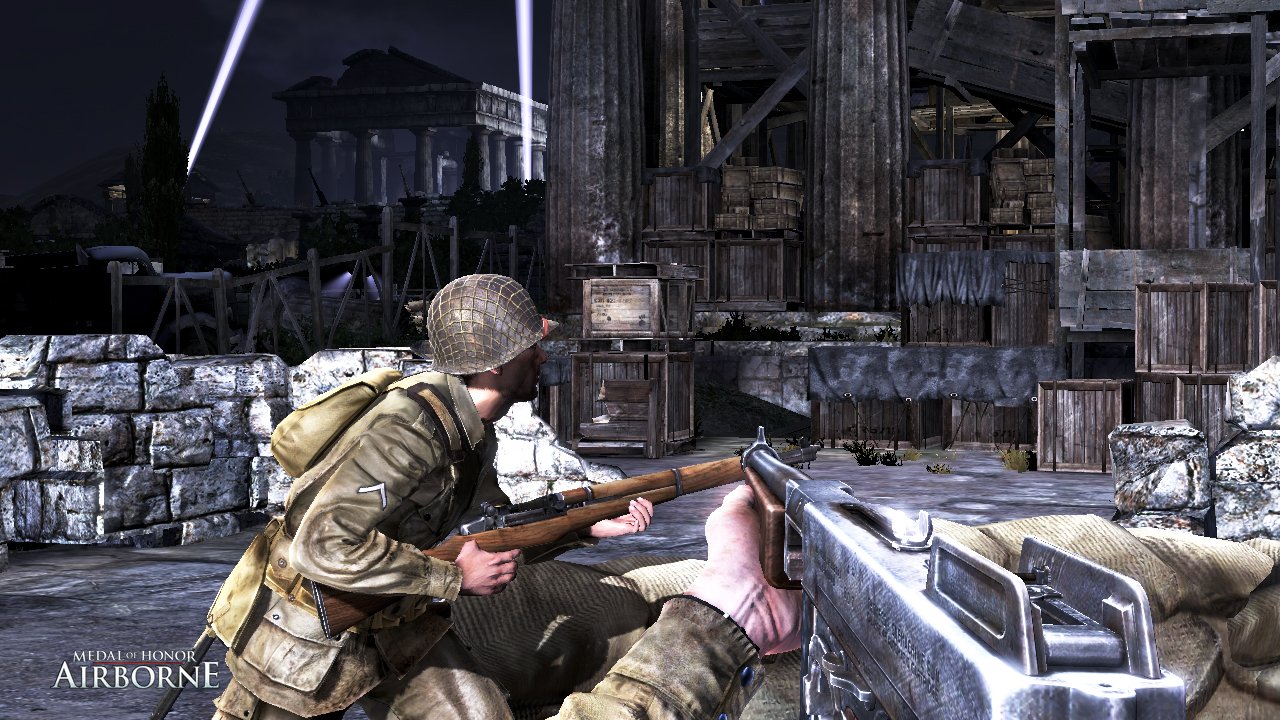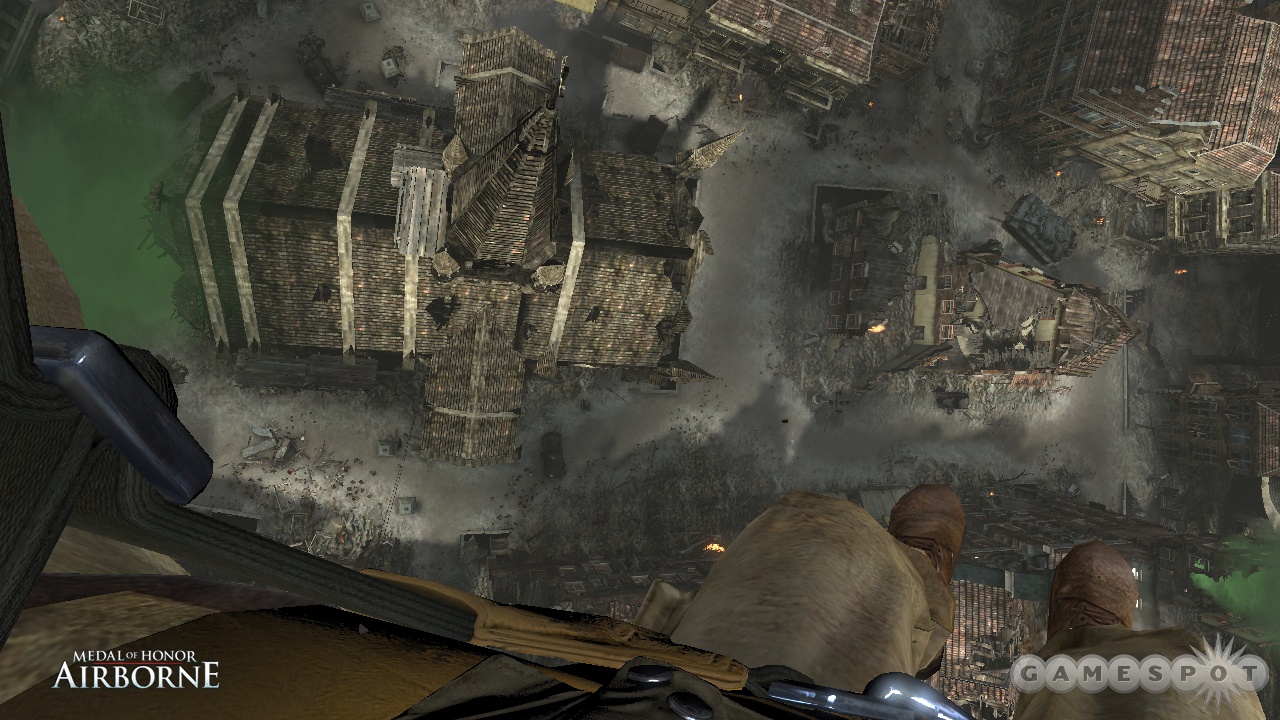Q&A: EA talks Medal of Honor: Airborne
We chat with Electronic Arts creative director Jon Paquette about making Medal of Honor: Airborne.
Since 1999, the Medal of Honor series has had its feet firmly planted on the ground--until now. Medal of Honor: Airborne places players in the shoes of Boyd Travers, a paratrooper in the 82nd Airborne, as he drops from the sky directly into enemy-packed missions. GameSpot AU caught up with Electronic Arts creative director Jon Paquette to talk about how the missions will play out, enemy artificial intelligence in the game, and more.
GameSpot AU: With the single-player campaign, how long will each mission take to play out? How big will the maps be?
Jon Paquette: With the open nature of our gameplay, a mission can take anywhere from one hour to three hours to complete for a first-time player. But the more you become familiar with the maps, the more "shortcuts" you can discover--especially taking advantage of the airdrop. Each map is relatively large--about the size of a small town in real-world proportions. Of course, you can drop anywhere you want within that mission, and depending on how you attack once you're on the ground, you may end up having a vastly different experience than your buddy who dropped somewhere else.

GS AU: Tell us about the mission structure.
JP: You play the game from the point of view of one character, Boyd Travers, a paratrooper in the 82nd Airborne. You are only required to play each mission once, but our design has a lot of built-in replay. Not only can you drop in a different place each time, there are also five "skill drops" in each mission that will earn you medals when completed. Furthermore, with the new weapon-upgrade system, you can replay missions and earn upgrades for your weapons, which will give you more firepower in the later missions.
GS AU: Parachuting into areas is obviously Airborne's main differentiator from previous WWII-themed games, with where you land your character greatly affecting the gameplay experience. How much more difficult is controlling your descent when playing at Airborne's higher difficulty levels?
JP: We don't scale the difficulty of the parachute mechanics, but we do scale the difficulty of the enemies. On higher difficulties, the enemies are faster, smarter, and more accurate. So when you land on a higher difficulty, you will have less time to react to the enemies around you, and landing on an enemy stronghold is tantamount to suicide. Furthermore, in the later levels, some advanced sniper enemies will actually shoot at you as you're in the air--so you have to work your chute controls to evade their attacks.
GS AU: Players can choose to land anywhere within the mission areas. Can you talk about how you've manipulated enemy AI to cope with the hundreds of different scenarios they could be faced with?
JP: Traditional, linear FPS games rely on a designer-controlled AI system, where the game designer attempts to anticipate player actions and manipulates the AI to make the best action moments occur. As soon as we realised that our players could start anywhere, we decided, as game designers, that we had to relinquish that control. Instead of following precedence, we built an AI system that understands the environment and reacts dynamically (i.e., systematically) to the player's choices. We stopped thinking about what the player was doing, and instead designed areas where the enemies would have a lot of options in how to defend their territory. Then, when the player uses different tactics against the enemy, the enemies survey the environment, find the most appropriate angle of attack, and take action. We did a lot of prototyping and a lot of trial and error to make the system work, and we're very proud of how the player has an infinite number of ways to attack their enemy. There are no "combat puzzles" in this game. You can defeat the enemies however you want.
GS AU: Multiplayer is all team-based play. Will the single-player campaign allow you to take control of allied soldiers and work as a team?
JP: We wanted to focus on a player-centric experience, where you could concentrate on what your character was doing, moment-to-moment, and the game would react to the choices you make. Giving the player control over additional allies felt outside of that scope, and we decided against it. Instead, we put a lot of intelligence into our allied AI, where they monitor how the player is performing and make smart decisions based on the player's actions. For example, if you're getting hit, and the enemy is winning, they'll recognise that and try to provide covering fire. They also call out enemy troop movements and hard targets (such as machine gun nests) to keep you up to date on what's happening in the battle.
GS AU: Why does multiplayer only allow up to 12 players per game?
JP: We did a lot of play testing and prototyping with our multiplayer and decided on 12 players because of the nature of our gameplay and the size of our maps. With more players, it became a little overwhelming to have that many paratroopers coming from the sky throughout the gameplay sessions. One thing that's unique about our multiplayer is that not only do you have to watch the map in front of you, but also the sky above you. Incoming paratroopers can kill you in one shot by landing on top of you and kicking you. We've had some epic games with 12 players, and it feels like the perfect balance for our multiplayer experience.

GS AU: On a different note, Letters from Iwo Jima was a highly acclaimed film because it showed WWII from a different perspective. Do you think we'll ever see a WWII FPS set from the Japanese or German perspective?
JP: It's always hard to compare passive entertainment (movies) and active entertainment (games). Filmmakers have a lot of tools to shape story and events; these tools help audiences empathise or even sympathise with the characters. Game makers have different tools. Our most powerful tool is our ability to let the audience live out a fantasy. Our audience can do whatever they want once they pick up the controller. I'm all for telling different stories from different perspectives, but I guess the real question would be is that what the gamers want. I don't think it is out of the realm of possibility to have WWII stories told from different perspectives though.
GS AU: Jon Paquette, thanks for your time.
Got a news tip or want to contact us directly? Email news@gamespot.com
Join the conversation